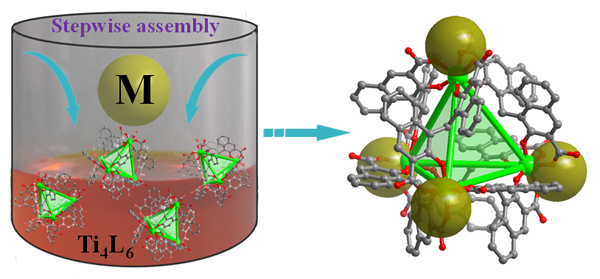[1] Cook, T. R.; Stang, P. J. Chem. Rev. 2015, 115, 7001.
[2] Castilla, A. M.; Ramsay, W. J.; Nitschke, J. R. Acc. Chem. Res. 2014, 47, 2063.
[3] Sun, Y. Y.; Zhuo, C.; Wang, F.; Zhang, J. Chin. J. Chem. 2020, 38, 449.
[4] Liu, J. B.; Li, P.; Yao, Z. J. Chin. J. Org. Chem. 2020, 40, 364(in Chinese). (刘金宝, 李鹏, 姚子健, 有机化学, 2020, 40, 364.)
[5] Chen, Z.; Liu, J.; Cui, H.; Zhang, L.; Su, C. Acta Chim. Sinica 2019, 77, 242(in Chinese). (陈之尧, 刘捷威, 崔浩, 张利, 苏成勇, 化学学报, 2019, 77, 242.)
[6] Saha, M. L.; Yan, X.; Stang, P. J. Acc. Chem. Res. 2016, 49, 2527.
[7] Bloch, W. M.; Abe, Y.; Holstein, J. J.; Wandtke, C. M.; Dittrich, B.; Clever, G. H. J. Am. Chem. Soc. 2016, 138, 13750.
[8] Cullen, W.; Turega, S.; Hunter, C. A.; Ward, M. D. Chem. Sci. 2015, 6, 625.
[9] Yoshizawa, M.; Klosterman, J. K.; Fujita, M. Angew. Chem. Int. Ed. 2009, 48, 3418.
[10] Brown, C. J.; Toste, F. D.; Bergman, R. G.; Raymond, K. N. Chem. Rev. 2015, 115, 3012.
[11] Sun, W.; Ye, L.; Liu, J.; Zheng, L.; Guo, W.; Han, S.; Shao, C.; Jiang, H. Chin. J. Org. Chem. 2019, 39, 2867(in Chinese). (孙卫东, 叶琳, 刘佳, 郑璐, 郭文彩, 韩森凯, 邵成园, 江华, 有机化学, 2019, 39, 2867.)
[12] Li, Y.; Zhang, W.; Liu, Z.; Xie, Z. Acta Chim. Sinica 2015, 73, 641(in Chinese). (李阳雪, 张巍, 刘智, 谢志刚, 化学学报, 2015, 73, 641.)
[13] Lorzing, G. R.; Gosselin, E. J.; Trump, B. A.; York, A. H. P.; Sturluson, A.; Rowland, C. A.; Yap, G. P. A.; Brown, C. M.; Simon, C. M.; Bloch, E. D. J. Am. Chem. Soc. 2019, 141, 12128.
[14] Niu, Z.; Wang, L.; Fang, S.; Lan, P. C.; Aguila, B.; Perman, J.; Ma, J.-G.; Cheng, P.; Li, X.; Ma, S. Chem. Sci. 2019, 10, 6661.
[15] Frischmann, P. D.; Kunz, V.; Wurthner, F. Angew. Chem. Int. Ed. 2015, 54, 7285.
[16] Endo, K.; Ube, H.; Shionoya, M. J. Am. Chem. Soc. 2020, 142, 407.
[17] Fleming, J. S.; Mann, K. L. V.; Carraz, C.-A.; Psillakis, E.; Jeffery, J. C.; McCleverty, J. A.; Ward, M. D. Angew. Chem. Int. Ed. 1998, 37, 1279.
[18] Zhu, H.-B.; Wu, Y.-F.; Lou, Y.-B.; Hu, J. Synth. Met. 2014, 190, 34.
[19] Zarra, S.; Smulders, M. M.; Lefebvre, Q.; Clegg, J. K.; Nitschke, J. R. Angew. Chem. Int. Ed. 2012, 51, 6882.
[20] Young, M. C.; Holloway, L. R.; Johnson, A. M.; Hooley, R. J. Angew. Chem. Int. Ed. 2014, 53, 9832.
[21] Wan, S.; Lin, L. R.; Zeng, L.; Lin, Y.; Zhang, H. Chem. Commun. 2014, 50, 15301.
[22] Wang, J.; He, C.; Wu, P.; Wang, J.; Duan, C. J. Am. Chem. Soc. 2011, 133, 12402.
[23] Yan, L. L.; Tan, C. H.; Zhang, G. L.; Zhou, L. P.; Bunzli, J. C.; Sun, Q. F. J. Am. Chem. Soc. 2015, 137, 8550.
[24] Li, K.; Zhang, L. Y.; Yan, C.; Wei, S. C.; Pan, M.; Zhang, L.; Su, C. Y. J. Am. Chem. Soc. 2014, 136, 4456.
[25] Loffler, S.; Lubben, J.; Krause, L.; Stalke, D.; Dittrich, B.; Clever, G. H. J. Am. Chem. Soc. 2015, 137, 1060.
[26] Bhat, I. A.; Samanta, D.; Mukherjee, P. S. J. Am. Chem. Soc. 2015, 137, 9497.
[27] Schweiger, M.; Seidel, S. R.; Arif, A. M.; Stang, P. J. Angew. Chem. Int. Ed. 2001, 40, 3467.
[28] Yuan, Q.-H.; Wan, L.-J.; Jude, H.; Stang, P. J. J. Am. Chem. Soc. 2005, 127, 16279.
[29] Brückner, C.; Powers, R. E.; Raymond, K. N. Angew. Chem. Int. Ed. 1998, 37, 1837.
[30] Davis, A. V.; Raymond, K. N. J. Am. Chem. Soc. 2005, 127, 7912.
[31] Albrecht, M.; Janser, I.; Burk, S.; Weis, P. Dalton Trans. 2006, 2875.
[32] Albrecht, M.; Burk, S.; Weis, P. Synthesis 2008, 18, 2963.
[33] Zhu, B. C.; Fang, W. H.; Wang, J.; Du, Y.; Zhou, T.; Wu, K.; Zhang, L.; Zhang, J. Chem. Eur. J. 2018, 24, 14358.
[34] Li, J.-R.; Timmons, D. J.; Zhou, H.-C. J. Am. Chem. Soc. 2009, 131, 6368.
[35] He, Y. P.; Yuan, L. B.; Chen, G. H.; Lin, Q. P.; Wang, F.; Zhang, L.; Zhang, J. J. Am. Chem. Soc. 2017, 139, 16845.
[36] He, Y. P.; Yuan, L. B.; Chen, G. H.; Zhang, L.; Zhang, J. Isr. J. Chem. 2018, 59, 233.
[37] Chen, G.-H.; Li, H.-Z.; He, Y.-P.; Zhang, S.-H.; Yi, X.; Liang, F.-P.; Zhang, L.; Zhang, J. Cryst. Growth Des. 2020, 20, 29.
[38] He, Y. P.; Chen, G. H.; Yuan, L. B.; Zhang, L.; Zhang, J. Inorg. Chem. 2020, 59, 964.
[39] He, Y.-P.; Yuan, L.-B.; Song, J.-S.; Chen, G.-H.; Lin, Q.; Li, C.; Zhang, L.; Zhang, J. Chem. Mater. 2018, 30, 7769.
[40] Kong, X.-J.; Ren, Y.-P.; Long, L.-S.; Zheng, Z.-P; Nichol, G.; Huang, R.-B.; Zheng, L.-S. Inorg. Chem. 2008, 47, 2728.
[41] Poncelet, O.; Hubert-Pfalzgraf, L. G.; Toupet, L.; Daran, J. C. Polyhedron 1991, 10, 2045.
[42] Taeb, A.; Krischner, H.; Kratky, C. Zeitschrift Für Kristallographie 1986, 177, 263.


